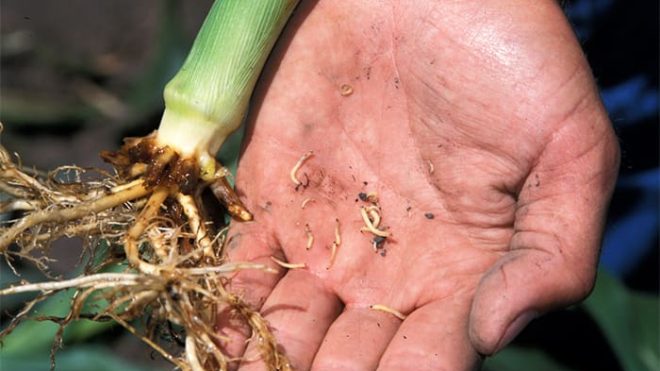Many articles and publications have brought forth that corn rootworm (CRW), primarily Northern and Western, is the number one annual pest in corn production. Most estimates put income losses and control costs at close to $1 billion per year.
The 2021 growing season is underway and net effects of CRW are yet to be seen. Still, the trend toward higher corn rootworm populations translates to increased CRW larval root feeding and CRW adult silk clipping and, subsequently, a greater impact on both corn standability and yields. What can we do now to manage our corn crop and reduce the impacts of CRW on our corn yields?
Scouting is the first step in working toward a pest management decision, whether for the 2021 corn crop (beetle damage) or next year’s corn crop (egg-laying). The map to the right was developed for CRW risk in the 2021 growing season based on beetle scouting counts from 2020.
CRW development similarly tracks corn development based on degree days.2 By the time rows typically close, CRW egg hatch and larval feeding is occurring. With early CRW scouting, we are digging corn plants with the soil attached, washing and/or soaking roots to float CRW larvae, and observing root feeding.
Root injury damage from CRW is rated using visual observations and applying the Nodal Injury Scale (NIS) developed by Iowa State University.3 For example, a NIS rating of 1.4 indicates the pruning of one complete node of roots and 40% of the next node. The NIS accounts for a root chewed within 1½ in. of the stalk as being pruned and included in the scoring. Experience and current academic review would indicate that root pruning at lengths greater than 1½ in. of the stalk can be nearly as detrimental, depending on the growing season stresses.
Monitoring roots for larval damage should commence by the end of July and be completed before significant root degradation or regeneration occurs. In general, there are no practical means to control CRW larvae once feeding has begun. However, by evaluating the extent of root injury, you can assess the impact of CRW pressure and ways to manage it.
- Affect yield potential: in-season management and marketing decisions
- Effectiveness of current strategies: rotation; seed treatments; insecticides; Bt trait(s) for CRW
- Quantify damage to determine if adult scouting and beetle control may be warranted
Scouting for beetles (adult CRW) during the egg-laying period (late July through early September) will provide information that is essential to delaying CRW resistance. Scouting for beetles is as important today as it was decades ago, and perhaps more so, because of the need to diversify management practices that reduce the potential for resistance to insecticides (seed treatment and soilapplied) and genetic Bt traits.
The process of beetle scouting is simple and doesn’t take much time when compared to the overall value. By establishing the level of adult populations during the current year, you can determine whether preventative treatments will be necessary for the following year’s corn crop OR if in-season adult CRW control, “beetle bombing” with a foliar-applied insecticide, is warranted.
Physical beetle scouting is described in the IPM of Corn Rootworms in North Dakota2. You will need to manage CRW populations the following year in corn if you find an average of 0.75 beetles per plant during any one of the field samplings. Iowa State University provides guidelines for using Sticky Traps as a beetle monitoring tool.5 Commonly accepted threshold for managing CRW in next year’s corn using properly managed Sticky Traps is two beetles/trap/day.
In-season “beetle bombing” comes into play if adult numbers are high or silk feeding is heavy. The earliest silking hybrids in a field are most often heavily damaged because beetles will move to them first in search of green silks. High beetle numbers are often required to seriously affect corn pollination. A commonly accepted threshold for potential damage based on beetle numbers is the presence of an average of 5 or more beetles/plant. Severe silk feeding and silks clipped to within ½ in. from the ear tip on 25% or more of the plants during pollen shed may also indicate a need to apply insecticide. Silk feeding that occurs after pollination is completedoes not affect yield potential.
Useful corn rootworm management data can, and should, be gathered during the month of August. Digging and washing roots will provide insight on efficacy of current rootworm management tactics. Scouting for beetles will give you perspective regarding forthcoming pressure in continuous corn fields.
~ Mike Blaine, CCA – Field Agronomist

